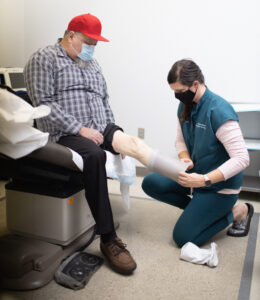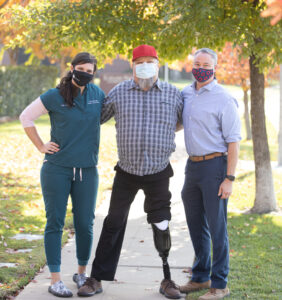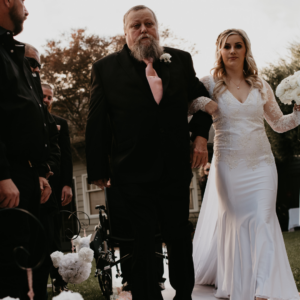When Leigh Ann O’Banion, MD, was completing her fellowship at the UCSF School of Medicine, she found that patients with a lower extremity amputation were spending almost a week in the hospital and taking six to eight months to begin walking independently again. When she became a physician at Valley Vascular Surgery Associates and UCSF faculty teaching at UCSF Fresno, she found a similar situation.
Convinced there was a way to improve patient outcomes, Dr. O’Banion created a multidisciplinary team that included all the resources a patient would need on their road to recovery. The team included health care professionals from Leon S. Peters Rehabilitation, San Joaquin Valley Rehabilitation, Community Regional Medical Center (CRMC), Hanger Prosthetics, peer counselors, social workers, and case managers.

A team approach is critical in providing information to patients before their operation and helps the patient understand and process what is happening and what to expect in terms of pain after their amputation. Including patients in the process from the very beginning produces better patient outcomes according to Dr. O’Banion.
With the team assembled, she began enrolling patients in the Lower Extremity Amputation Pathway (LEAP) study in March of 2019.
When Hanford resident Raymond Whaley accidentally stepped into a pothole and fractured his ankle on a chilly December night in 2019, he had no idea that he would become one of Dr. O’Banion’s LEAP study patients.
Through December and into January 2020, Raymond sought treatment for his ankle. When issues with his ankle worsened, he went to his podiatrist. His foot was swollen, discolored, and extremely painful. As a diabetes patient, Raymond was concerned that doctors would have to amputate part of his leg. While he was somewhat mentally prepared to hear that news, his wife was not. Their youngest daughter was getting married in a few weeks, and, as many fathers dream of doing, Raymond was going to walk her down the aisle.
After examining his ankle, Raymond’s podiatrist, Emmy Oji, DPM, of Valley Foot & Ankle Specialty Providers, called Dr. O’Banion. They found that Raymond had adequate blood flow in the big arteries of his leg and thought Raymond would heal very well with a below-the-knee amputation. Dr. Oji then sent Raymond directly to the Emergency Department at CRMC. With the goal of walking his daughter down the aisle, his diabetes, and the type of amputation needed, Raymond was an ideal candidate for the LEAP study.
Members of the LEAP team met Raymond and his wife at CRMC. “I was in such pain that I was out of it, but I do remember that when I went in there… they got the team together, and… were telling me about everything and how it was going to go, they were going to do the surgery in the morning, and I said ‘Ok, I’m ready for it,”‘ Raymond said.

Raymond had the lower part of his leg amputated the morning after arriving at CRMC. The weeks that followed were the whirl-wind of hard work, dedication, and determination Raymond had prepared for with the LEAP team.
The day after his amputation, Raymond met with the physical therapy team to start learning how to sit up, move from the bed to the wheelchair, and discuss further physical therapy. Two days after the operation, Raymond headed to Leon S. Peters Rehabilitation Hospital where he underwent two weeks of intense physical therapy. He then headed home determined to continue relearning how to walk.
Knowing how important it was for Raymond to be prepared for his daughter’s wedding, Joe Beall with Hanger Prosthetics met frequently with Raymond to ensure he received his prosthetic in time. One week before the wedding, Raymond received a prosthetic leg that would allow him to begin the next phase of physical therapy and start learning how to use a prosthetic leg.
Dr. O’Banion was amazed at Raymond’s progress at a follow-up appointment after his surgery. Raymond told her, “I’m just trying so hard because everything within me wants to walk my daughter down the aisle, and I promised her, and I can’t back down.”
On March 5, just two days before his daughter’s wedding, Raymond received his custom-fit prosthetic. That day, in his Hanford home, Raymond was able to walk independently with a prosthetic for the first time.
The next day, the Whaley family headed to Cambria, California for the rehearsal dinner. As Raymond’s son rolled him down the aisle while he was wearing a shirt that said “This wedding cost me an arm and a leg,” no one but Raymond and his wife knew that he would be able to walk his daughter down the aisle the following afternoon.

On March 7, 2020, as Raymond’s son began rolling him down the aisle in his wheelchair, Raymond stopped him. ‘Tm going to walk my baby down the aisle,” he said.
Stunned, everyone, including his daughter, watched as Raymond stood, placed his daughter’s arm in his, and walked her down the aisle, just seven weeks after his amputation.
“When you go through a tragic thing like I went through and they pick a surgeon and they come and are introduced to you, really listen to what they’re telling you. What they’re telling you is going to help you. And you just have to be positive,” Raymond said.
While Raymond’s case was exceptional, the preliminary findings of the LEAP study are just as astounding. On average, patients enrolled in the LEAP study leave the hospital three days earlier, begin physical therapy two days sooner, and receive a prosthetic 56 days earlier than patients not enrolled in the study. Study participants also begin walking independently with their prosthetic on average two months earlier.
“The ultimate goal would be to implement this protocol in all hospitals across the country as the members of this team exist in all hospitals. It’s just a matter of getting people working together toward a common goal,” said Dr. O’Banion.
Dr. O’Banion is one step closer to that goal. Due to the significance of the preliminary findings, all three of Community Medical Centers’ hospitals will now be adopting the LEAP study protocols as a standard of care for lower extremity amputees.
